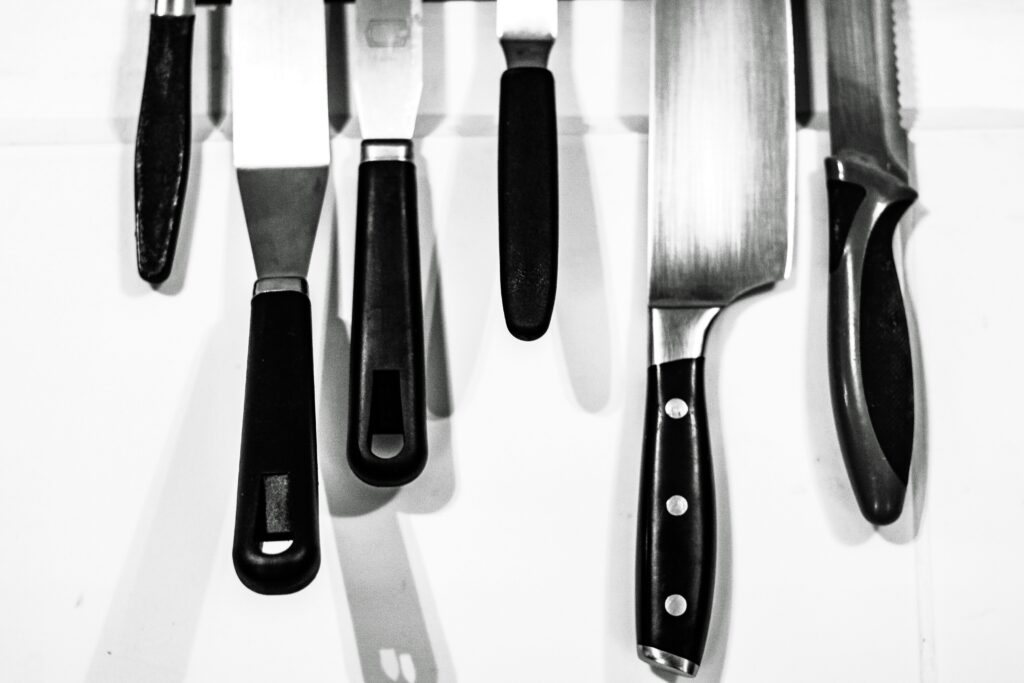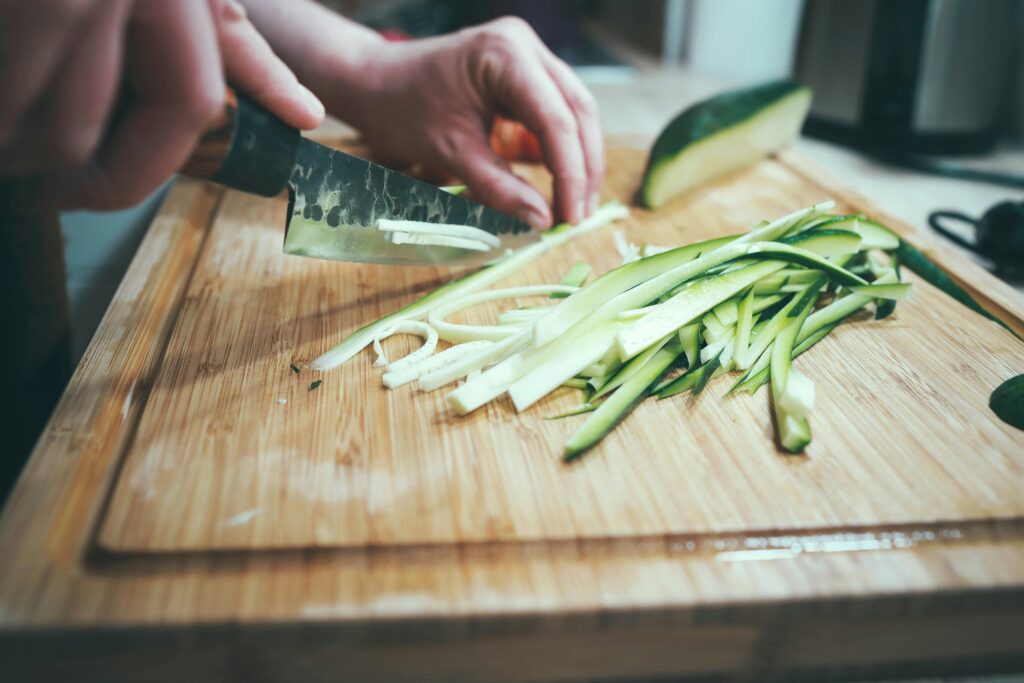Mastering Knife Skills: Essential Techniques for Safe and Efficient Chopping.

Introduction to Knife Safety
| Knife safety is paramount in the kitchen to prevent accidents and ensure efficient and enjoyable cooking experiences. One of the fundamental aspects of knife safety is understanding how to properly hold and grip a knife. By mastering the correct grip, you not only reduce the risk of accidents but also improve your control and precision while cutting ingredients. When holding a knife, it’s essential to maintain a firm yet relaxed grip, ensuring that your fingers are positioned safely away from the blade’s edge. Additionally, adopting the correct hand positioning and posture further minimizes the likelihood of slips and injuries. With these foundational techniques in place, you can confidently approach kitchen tasks with precision and peace of mind. |

Types of Knives
- Chef’s Knife : A versatile, all-purpose knife with a broad blade and tapered tip, ideal for chopping, slicing, dicing, and mincing a wide range of ingredients. Also known as a cook’s knife or French knife.
- Paring Knife : A small, narrow-bladed knife with a pointed tip, perfect for precision tasks such as peeling, trimming, and intricate cutting work like deveining shrimp or coring fruits.
- Serrated Knife : Featuring a saw-like edge, Serrated knives are excellent for cutting through tough or crusty exteriors without crushing delicate interiors, making them ideal for slicing bread, tomatoes, and cakes.
- Utility Knife : A smaller version of a chef’s knife, utility knives are versatile and suitable for a variety of tasks, including slicing sandwiches, trimming small fruits and vegetables, and light-duty cutting work.
- Boning Knife : Designed for removing bones from meat, poultry, and fish, boning knives feature a narrow, flexible blade that allows for precise maneuvering around bones and joints.
- Santoku Knife : Originating from Japan, Santoku knives have a distinctive flat edge and a sheepsfoot-shaped blade, making them well-suited for slicing, dicing, and mincing vegetables, herbs, and meats.
- Cleaver : With a large, rectangular blade and considerable weight, cleavers are primarily used for heavy-duty tasks such as chopping through bones, splitting poultry, and crushing garlic cloves.
- Bread Knife : Featuring a long, serrated blade, bread knives are designed to effortlessly slice through crusty bread and delicate pastries without squashing or tearing them.
- Filleting Knife : Thin and flexible, filleting knives are specifically designed for removing bones and skin from fish, allowing for precise filleting and deboning with minimal waste.
- Carving Knife : Long, narrow, and sharp, carving knives are used for slicing cooked meats, poultry, and roasts into thin, even slices, making them ideal for presentation at the table.
Each type of knife serves a specific purpose in the kitchen, and having the right tool for the task can greatly enhance efficiency and precision in food preparation.
Knife Anatomy
Understanding the anatomy of a knife is essential for proper use and maintenance. A typical knife consists of several key components, including the blade, handle, bolster, and tang. The blade is the cutting edge of the knife, varying in shape and size depending on its intended use. The handle provides a grip for the user and can be made from various materials such as wood, plastic, or metal. The bolster is the thick junction between the blade and handle, adding balance and stability to the knife. Finally, the tang is the portion of the blade that extends into the handle, providing strength and durability. By familiarizing yourself with these components, you can better understand how knives function and how to care for them to ensure longevity and optimal performance.

Knife Maintenance
Proper maintenance is essential for keeping knives in optimal condition and ensuring safe and efficient use. Regular maintenance includes sharpening and honing the blade to maintain its sharpness and edge retention. Sharpening removes metal from the blade to create a new edge, while honing realigns the blade’s edge without removing material. Additionally, knives should be cleaned and dried thoroughly after each use to prevent corrosion and bacterial growth. Storing knives in a designated knife block, sheath, or magnetic strip helps protect the blade and prevents damage. By incorporating these maintenance practices into your routine, you can prolong the lifespan of your knives and maintain their cutting performance for years to come.
Knife Techniques
Mastering fundamental knife techniques is essential for efficient and precise food preparation in the kitchen. Key techniques include slicing, chopping, dicing, mincing, and julienning. Slicing involves cutting ingredients into thin, uniform pieces, while chopping creates coarser cuts with a downward motion. Dicing produces small, even cubes, while mincing involves finely chopping ingredients into tiny pieces. Julienning results in thin, matchstick-like strips. Proper hand positioning and knife control are crucial for safety and accuracy when executing these techniques. By practicing and honing these fundamental skills, you can enhance your culinary prowess and streamline your cooking process.


Ingredient Preparation
| Efficient and safe ingredient preparation begins with mastering proper knife skills for various types of ingredients. When handling vegetables, it’s important to choose the appropriate cutting technique based on the specific texture and shape desired. For example, sturdy vegetables like carrots and potatoes may be best suited for slicing or dicing, while delicate vegetables like tomatoes or mushrooms may require a gentler touch to avoid crushing. Fruits can be peeled, sliced, or diced depending on the recipe, with care taken to remove any pits or seeds as needed. Herbs should be finely chopped using a rocking motion with the knife to release their flavors without bruising or wilting. When preparing proteins such as poultry, fish, or meat, proper techniques for trimming, deboning, and portioning ensure even cooking and optimal presentation. By applying these principles of ingredient preparation and knife skills, you can efficiently transform raw ingredients into beautifully crafted dishes with precision and ease. |
Cutting Board Care
| Selecting the right cutting board material is crucial for maintaining both the longevity of your knives and the safety of your food. Wooden cutting boards are popular for their durability and knife-friendliness, but they require regular oiling to prevent drying out and warping. Plastic cutting boards are non-porous and dishwasher-safe, making them easy to clean and sanitize, but they can develop deep knife grooves over time. Bamboo cutting boards offer a balance of durability and sustainability, but they may also develop knife marks and require regular oiling. Regardless of the material, cutting boards should be cleaned promptly after each use with hot, soapy water and thoroughly dried to prevent bacterial growth. To sanitize cutting boards, especially after cutting raw meat, poultry, or fish, use a solution of diluted bleach or vinegar. Regularly oiling wooden or bamboo cutting boards helps maintain their moisture content and prevents cracking. By following these guidelines, you can ensure your cutting boards remain clean, sanitary, and free from cross-contamination, prolonging their lifespan and promoting food safety in your kitchen. |

Troubleshooting
| In the kitchen, it’s common to encounter challenges while using knives. Some common mistakes include using dull blades, resulting in ragged cuts and increased risk of slipping, and applying too much pressure while cutting, leading to hand fatigue and less control over the knife. To avoid these issues, regularly sharpen your knives using a sharpening stone or honing steel to maintain a sharp edge. Additionally, use proper cutting techniques, allowing the sharpness of the knife to do the work rather than relying on force. Uneven cuts can occur when the cutting surface is not stable or when the knife is not held at the correct angle. To prevent this, ensure your cutting board is secure and use a consistent cutting motion. If hand fatigue becomes an issue, take breaks as needed and consider using ergonomic knife handles or grips to reduce strain on your hands and wrists. By addressing these common issues and implementing proper techniques, you can improve your knife skills and enhance your overall cooking experience. |